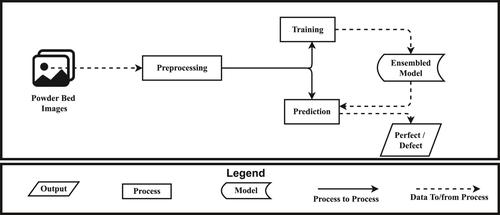当前位置:
X-MOL 学术
›
IET Optoelectron.
›
论文详情
Our official English website, www.x-mol.net, welcomes your feedback! (Note: you will need to create a separate account there.)
Ensemble learning based defect detection of laser sintering
IET Optoelectronics ( IF 2.3 ) Pub Date : 2023-10-30 , DOI: 10.1049/ote2.12108 Junyi Xin 1 , Muhammad Faheem 2 , Qasim Umer 3, 4 , Muhammad Tausif 4 , M. Waqar Ashraf 5
IET Optoelectronics ( IF 2.3 ) Pub Date : 2023-10-30 , DOI: 10.1049/ote2.12108 Junyi Xin 1 , Muhammad Faheem 2 , Qasim Umer 3, 4 , Muhammad Tausif 4 , M. Waqar Ashraf 5
Affiliation

|
In rapid development, Selective Laser Sintering (SLS) creates prototypes by processing industrial materials, for example, polymers. Such materials are usually in powder form and fused by a laser beam. The manufacturing quality depends on the interaction between a high-energy laser beam and the powdered material. However, in-homogeneous temperature distribution, unstable laser powder, and inconsistent powder densities can cause defects in the final product, for example, Powder Bed Defects. Such factors can lead to irregularities, for example, warping, distortion, and inadequate powder bed fusion. These irregularities may affect the profitable SLS production. Consequently, detecting powder bed defects requires automation. An ensemble learning-based approach is proposed for detecting defects in SLS powder bed images from this perceptive. The proposed approach first pre-processes the images to reduce the computational complexity. Then, the Convolutional Neural Network (CNN) based ensembled models (off-the-shelf CNN, bagged CNN, and boosted CNN) are implemented and compared. The ensemble learning CNN (bagged and boosted CNN) is good for powder bed detection. The evaluation results indicate that the performance of bagged CNN is significant. It also indicates that preprocessing of the images, mainly cropping to the region of interest, improves the performance of the proposed approach. The training and testing accuracy of the bagged CNN is 96.1% and 95.1%, respectively.
中文翻译:

基于集成学习的激光烧结缺陷检测
在快速发展中,选择性激光烧结 (SLS) 通过加工工业材料(例如聚合物)来创建原型。此类材料通常为粉末形式并通过激光束熔化。制造质量取决于高能激光束与粉末材料之间的相互作用。然而,不均匀的温度分布、不稳定的激光粉末和不一致的粉末密度可能会导致最终产品出现缺陷,例如粉床缺陷。这些因素可能导致不规则现象,例如翘曲、变形和粉末床熔合不充分。这些违规行为可能会影响 SLS 生产的盈利能力。因此,检测粉末床缺陷需要自动化。提出了一种基于集成学习的方法,用于从这种感知中检测 SLS 粉床图像中的缺陷。所提出的方法首先对图像进行预处理以降低计算复杂度。然后,实现并比较基于卷积神经网络 (CNN) 的集成模型(现成的 CNN、bagged CNN 和 boosted CNN)。集成学习 CNN(袋装和增强 CNN)非常适合粉床检测。评估结果表明bagged CNN的性能显着。它还表明图像的预处理(主要是裁剪到感兴趣的区域)提高了所提出方法的性能。 bagged CNN 的训练和测试准确率分别为 96.1% 和 95.1%。
更新日期:2023-10-30
中文翻译:

基于集成学习的激光烧结缺陷检测
在快速发展中,选择性激光烧结 (SLS) 通过加工工业材料(例如聚合物)来创建原型。此类材料通常为粉末形式并通过激光束熔化。制造质量取决于高能激光束与粉末材料之间的相互作用。然而,不均匀的温度分布、不稳定的激光粉末和不一致的粉末密度可能会导致最终产品出现缺陷,例如粉床缺陷。这些因素可能导致不规则现象,例如翘曲、变形和粉末床熔合不充分。这些违规行为可能会影响 SLS 生产的盈利能力。因此,检测粉末床缺陷需要自动化。提出了一种基于集成学习的方法,用于从这种感知中检测 SLS 粉床图像中的缺陷。所提出的方法首先对图像进行预处理以降低计算复杂度。然后,实现并比较基于卷积神经网络 (CNN) 的集成模型(现成的 CNN、bagged CNN 和 boosted CNN)。集成学习 CNN(袋装和增强 CNN)非常适合粉床检测。评估结果表明bagged CNN的性能显着。它还表明图像的预处理(主要是裁剪到感兴趣的区域)提高了所提出方法的性能。 bagged CNN 的训练和测试准确率分别为 96.1% 和 95.1%。











































 京公网安备 11010802027423号
京公网安备 11010802027423号